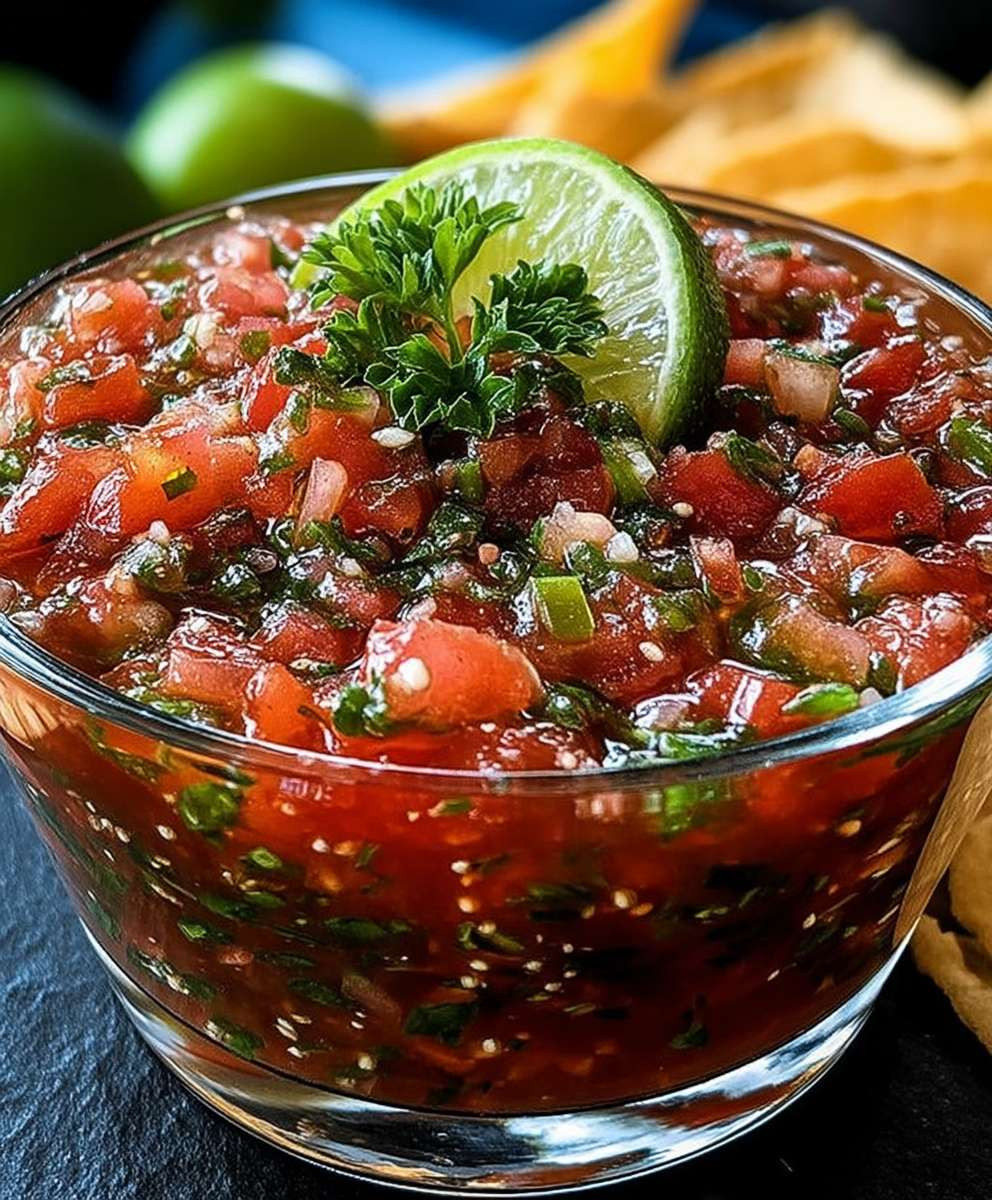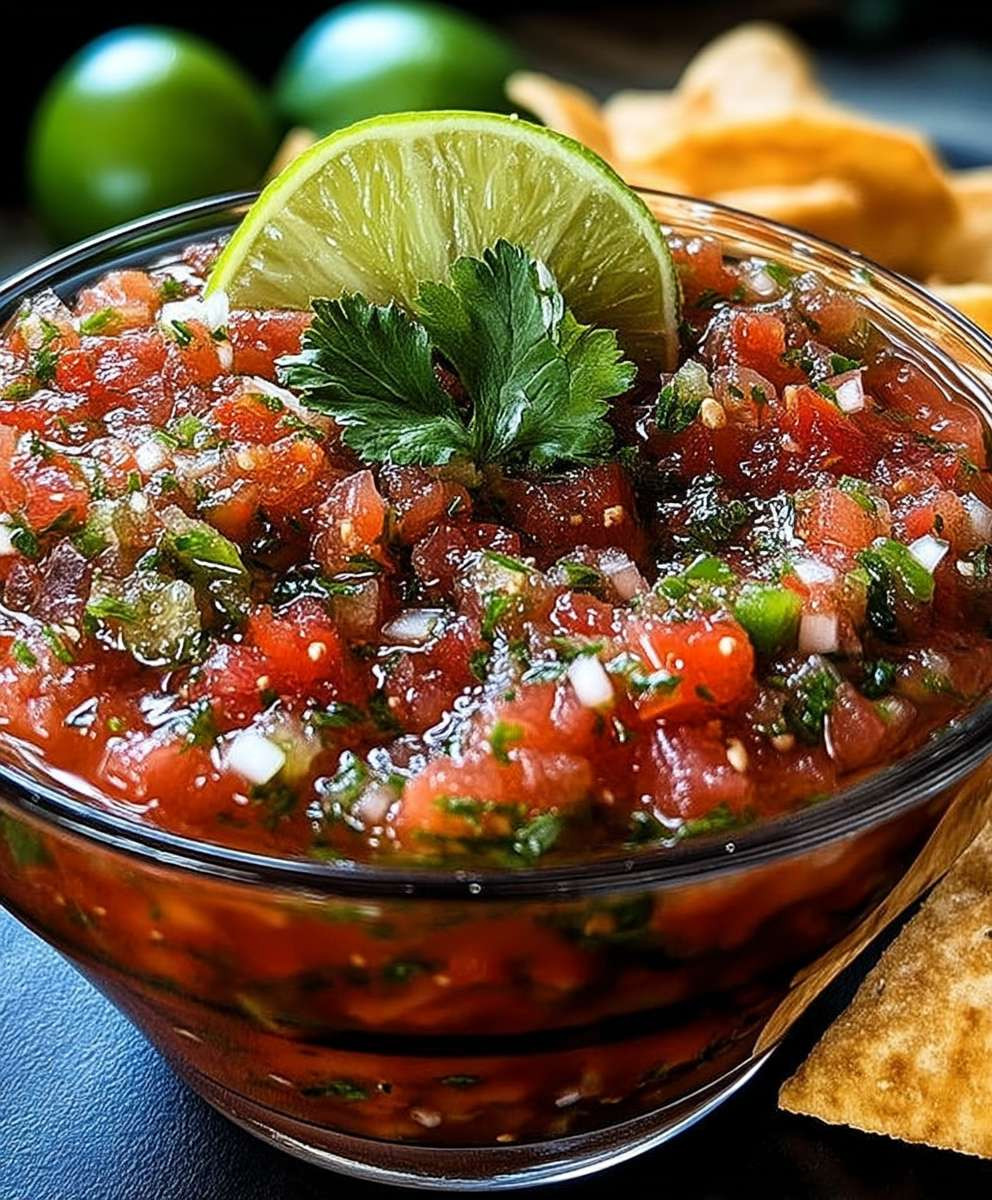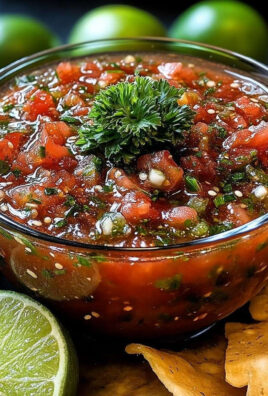Homemade Salsa: Forget the jarred stuff! Are you ready to experience a flavor explosion that will tantalize your taste buds and leave you craving more? This isn’t just any salsa; it’s a vibrant, fresh, and utterly addictive condiment that will elevate your chips, tacos, grilled meats, and everything in between. I’m going to show you how to make the best salsa you’ve ever tasted, right in your own kitchen.
Salsa, meaning “sauce” in Spanish, has a rich history deeply intertwined with the culinary traditions of Mexico and Latin America. For centuries, indigenous cultures have been crafting variations of this flavorful concoction, using locally sourced ingredients like tomatoes, chilies, and herbs. It’s a testament to the power of simple, fresh ingredients transformed into something truly extraordinary.
What makes homemade salsa so irresistible? It’s the perfect balance of sweet, spicy, and tangy flavors, combined with a satisfyingly chunky texture. The bright acidity of the tomatoes, the fiery kick of the chilies, and the aromatic freshness of the cilantro create a symphony of flavors that dance on your palate. Plus, making it yourself allows you to customize the heat level and ingredients to your exact preferences. Whether you like it mild, medium, or scorching hot, this recipe is your blank canvas. Get ready to ditch the store-bought stuff forever and embrace the vibrant world of homemade salsa!
Ingredients:
- 10 ripe Roma tomatoes, cored and roughly chopped
- 1 large white onion, roughly chopped
- 4-6 cloves garlic, peeled
- 2-4 jalapeño peppers, stemmed and roughly chopped (remove seeds for milder salsa)
- 1 red bell pepper, stemmed, seeded, and roughly chopped
- 1 green bell pepper, stemmed, seeded, and roughly chopped
- 1 bunch cilantro, roughly chopped (about 1 cup packed)
- 2 limes, juiced
- 1 tablespoon ground cumin
- 1 teaspoon dried oregano
- 1/2 teaspoon sugar (optional, to balance acidity)
- Salt, to taste
- Freshly ground black pepper, to taste
Preparing the Vegetables:
Okay, let’s get started! The key to a great homemade salsa is using fresh, high-quality ingredients. I always start by prepping all my veggies. This makes the whole process flow much smoother.
- Wash and Chop the Tomatoes: Rinse your Roma tomatoes thoroughly under cold water. Core them by cutting out the hard stem end with a paring knife. Then, roughly chop them into large chunks. Don’t worry about making them perfect; they’ll be blended later.
- Prepare the Onion: Peel the large white onion and roughly chop it into quarters. Again, no need for perfection here.
- Peel the Garlic: Peel all 4-6 cloves of garlic. I like to use a garlic press, but you can also mince them finely if you prefer. The amount of garlic is really up to your taste. If you’re a garlic lover like me, go for the full 6 cloves!
- Handle the Jalapeños with Care: This is important! Wear gloves if you have sensitive skin. Stem the jalapeño peppers and roughly chop them. Now, here’s the crucial part: the seeds and membranes are where most of the heat resides. If you want a milder salsa, remove the seeds and membranes before chopping. For a spicier salsa, leave them in. I usually remove about half the seeds for a nice balance.
- Prepare the Bell Peppers: Stem and seed both the red and green bell peppers. Roughly chop them into large pieces. The bell peppers add a lovely sweetness and color to the salsa.
- Chop the Cilantro: Rinse the cilantro thoroughly and pat it dry. Roughly chop the entire bunch, including the stems (the stems have a lot of flavor!). I usually use about a cup of packed cilantro.
Blending the Salsa:
Now for the fun part – blending everything together! You can use a food processor or a blender for this. I prefer a food processor because it gives me more control over the texture. I like my salsa a little chunky, but you can blend it to your desired consistency.
- First Pulse: Add the tomatoes, onion, garlic, jalapeños, and bell peppers to the food processor or blender. Pulse a few times until everything is coarsely chopped. Be careful not to over-blend at this stage; you want some texture.
- Add the Cilantro and Spices: Add the chopped cilantro, lime juice, cumin, oregano, and sugar (if using) to the food processor or blender.
- Blend to Desired Consistency: Pulse again, this time blending until the salsa reaches your desired consistency. I usually pulse it about 5-10 times, checking the texture after each pulse. Remember, you can always blend it more, but you can’t un-blend it!
- Taste and Adjust: This is the most important step! Taste the salsa and adjust the seasoning as needed. Add salt and pepper to taste. If it’s too acidic, add a pinch more sugar. If it’s not spicy enough, add a pinch of cayenne pepper or a few more drops of hot sauce. If it’s too thick, add a tablespoon or two of water or tomato juice to thin it out.
Chilling and Serving:
The final step is to chill the salsa. This allows the flavors to meld together and develop. I find that the salsa tastes even better after it’s been chilled for a few hours.
- Transfer to a Container: Transfer the salsa to an airtight container.
- Chill in the Refrigerator: Refrigerate for at least 2 hours, or preferably overnight.
- Serve and Enjoy: Serve the salsa with your favorite tortilla chips, tacos, burritos, or anything else you like! It’s also delicious as a topping for grilled chicken or fish.
Tips and Variations:
Here are a few tips and variations to help you customize your homemade salsa:
- Roasting the Vegetables: For a smoky flavor, roast the tomatoes, onion, garlic, and jalapeños before blending. Toss them with olive oil and roast them in a 400°F (200°C) oven for about 20-30 minutes, or until they are softened and slightly charred.
- Adding Fruit: For a sweeter salsa, add some chopped mango, pineapple, or peaches.
- Using Different Peppers: Experiment with different types of peppers, such as serrano peppers, habanero peppers, or chipotle peppers. Remember to adjust the amount of pepper to your desired level of spiciness.
- Adding Corn or Black Beans: For a heartier salsa, add some cooked corn or black beans.
- Making it Ahead: Homemade salsa can be made up to 3 days in advance. Store it in an airtight container in the refrigerator.
- Freezing Salsa: You can freeze salsa, but the texture may change slightly. To freeze, transfer the salsa to a freezer-safe container and freeze for up to 3 months. Thaw in the refrigerator overnight before serving.
- Spice Level Control: Remember, you can always add more spice, but you can’t take it away! Start with a small amount of jalapeño and taste as you go. If you accidentally make it too spicy, add a little more tomato or bell pepper to mellow it out. A squeeze of lime juice can also help balance the heat.
- Texture Preferences: Some people prefer a very smooth salsa, while others like it chunky. Experiment with different blending times to find your perfect texture. You can also reserve some of the chopped vegetables and add them back in after blending for extra chunkiness.
- Lime Juice is Key: Don’t skimp on the lime juice! It adds a bright, tangy flavor that really makes the salsa pop. Freshly squeezed lime juice is always best.
- Salt is Your Friend: Salt is essential for bringing out the flavors of the vegetables. Don’t be afraid to add a generous amount of salt, but always taste as you go.
Troubleshooting:
Sometimes, things don’t go exactly as planned. Here are a few common salsa problems and how to fix them:
- Salsa is Too Watery: If your salsa is too watery, drain off some of the excess liquid after blending. You can also add a tablespoon of tomato paste to thicken it up.
- Salsa is Too Thick: If your salsa is too thick, add a tablespoon or two of water or tomato juice to thin it out.
- Salsa is Too Acidic: If your salsa is too acidic, add a pinch more sugar to balance the acidity.
- Salsa is Too Bland: If your salsa is too bland, add more salt, pepper, cumin, or oregano. You can also add a squeeze of lime juice or a dash of hot sauce.
Serving Suggestions:
Homemade salsa is incredibly versatile! Here are just a few ideas for how to use it:
- With Tortilla Chips: This is the classic way to enjoy salsa!
- On Tacos and Burritos: Add a spoonful of salsa to your favorite tacos and burritos for extra flavor and spice.
- As a Topping for Grilled Chicken or Fish: Salsa makes a delicious and healthy topping for grilled chicken or fish.
- In Scrambled Eggs: Add a spoonful of salsa to your scrambled eggs for a flavorful and spicy breakfast.
- On Nachos: Top your nachos with salsa, cheese, and your favorite toppings.
- As a Salad Dressing: Thin out the salsa with a little olive oil and vinegar for a flavorful and healthy salad dressing.
- With Quesadillas: Serve salsa alongside quesadillas for dipping.
I hope you enjoy this recipe for homemade salsa! It’s a simple and delicious way to add flavor and spice to your meals. Feel free to experiment with different ingredients and variations to create your own signature salsa. Happy cooking!

Conclusion:
This homemade salsa recipe isn’t just another dip; it’s a vibrant explosion of fresh flavors that will elevate your snacking game and impress your friends and family. Trust me, once you taste the difference between store-bought and this freshly made delight, you’ll never go back! The bright acidity of the tomatoes, the subtle heat of the peppers, and the herbaceous cilantro all come together in perfect harmony. It’s incredibly easy to make, requiring minimal effort for maximum flavor payoff. You control the ingredients, ensuring a healthy and delicious snack free from artificial preservatives and excessive sodium often found in commercial salsas.
But the best part? It’s incredibly versatile!
Serving Suggestions and Variations
Think beyond just tortilla chips! This salsa is fantastic with grilled chicken or fish, adding a zesty kick to your tacos or burritos. I personally love spooning it over scrambled eggs for a flavorful breakfast boost. You can even use it as a base for a quick and easy pasta sauce by simply sautéing some garlic and adding the salsa to simmer.
For a milder version, simply reduce the amount of jalapeño or remove the seeds and membranes before dicing. If you’re a heat seeker, consider adding a serrano pepper or a pinch of cayenne pepper for an extra fiery kick. Want a sweeter salsa? Try adding a touch of honey or a few diced mangoes or peaches. The possibilities are truly endless!
Another variation I often make is a roasted tomato salsa. Roasting the tomatoes, onions, and peppers before blending adds a smoky depth of flavor that is absolutely irresistible. Just toss the vegetables with olive oil and roast at 400°F (200°C) until softened and slightly charred, then proceed with the recipe as directed.
You can also experiment with different types of tomatoes. Roma tomatoes are a classic choice, but heirloom tomatoes offer a unique and complex flavor profile. Cherry tomatoes or grape tomatoes can also be used for a sweeter and more delicate salsa.
Don’t be afraid to get creative with your herbs as well. While cilantro is the traditional choice, you can also try adding a bit of parsley, oregano, or even mint for a unique twist.
And remember, the key to a great salsa is fresh ingredients. Use the ripest, most flavorful tomatoes you can find, and don’t skimp on the cilantro!
Give it a Try!
I truly believe that this homemade salsa recipe is a must-try for anyone who loves fresh, flavorful food. It’s quick, easy, and incredibly satisfying. So, gather your ingredients, put on some music, and get ready to create a salsa masterpiece!
I’m so confident that you’ll love this recipe, and I can’t wait to hear about your experience. Did you try any variations? What did you serve it with? What did your friends and family think? Please, share your thoughts and photos in the comments below! Your feedback is invaluable, and it helps me continue to create and share delicious recipes that you’ll love. Happy salsa-making!
Homemade Salsa: The Ultimate Guide to Fresh & Flavorful Recipes
Fresh, flavorful homemade salsa bursting with ripe tomatoes, onions, garlic, peppers, cilantro, and lime. Easy to customize to your preferred level of spice and chunkiness.
Ingredients
Instructions
Recipe Notes
- For a smoky flavor, roast the vegetables before blending.
- Add chopped mango, pineapple, or peaches for a sweeter salsa.
- Experiment with different types of peppers for varying levels of spice.
- Add cooked corn or black beans for a heartier salsa.
- Homemade salsa can be made up to 3 days in advance.
- Freeze salsa for up to 3 months.
- Start with a small amount of jalapeño and taste as you go.
- Experiment with different blending times to find your perfect texture.
- Freshly squeezed lime juice is always best.
- Salt is essential for bringing out the flavors of the vegetables.
- If your salsa is too watery, drain off some of the excess liquid after blending.
- If your salsa is too thick, add a tablespoon or two of water or tomato juice to thin it out.
- If your salsa is too acidic, add a pinch more sugar to balance the acidity.
- If your salsa is too bland, add more salt, pepper, cumin, or oregano.





Leave a Comment